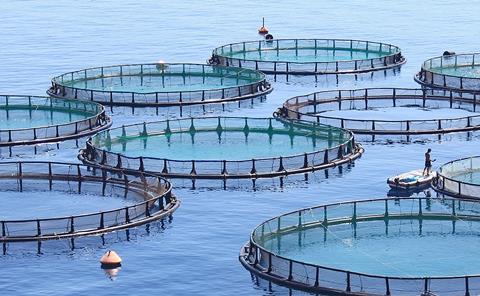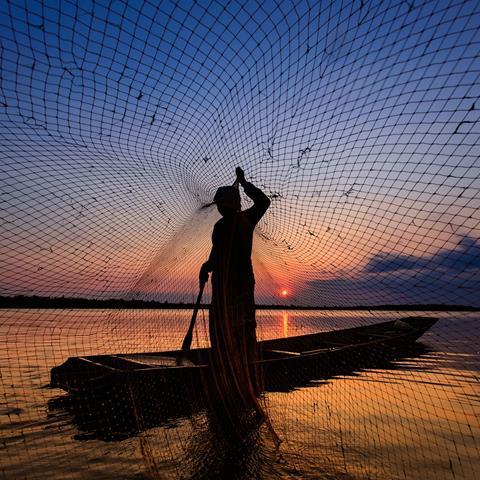Farmed fish is an essential element of the world’s piscine supply, with half of the fish used today – for food, fishmeal, or products like fish oil – coming from aquaculture-based sources. The percentage of farmed fish on the market is only set to continue to grow, as consumer demand increases and as fishing in oceans, lakes, and streams faces several issues, including overfishing.
But fish farming has a serious impact on the environment, as well as on human health. Fish farms rely heavily on antibiotics and chemicals to keep the environment clean and fish disease-free. While filtering systems do help, they are not enough, due to the fish being housed in an enclosed area, without a strong flow of water entering and exiting, fish waste and uneaten food still accumulate – leading to pollution of the area that could affect the health of the fish and leaving farmers reliant on antibiotics and chemicals.
These additives and antibiotics can have a major impact on farmed fish and consumers, to the extent that health officials advise consuming some of the most popular species only infrequently or even rarely or to avoid some farmed fish altogether. And this impact is not limited to the farms themselves. Chemicals and antibiotics can seep out to the open sea via the filters used to keep farm areas clean, and they can be consumed by wild fish and then eaten by humans, further upsetting the natural balance among fish species and further contributing to the deterioration of the effectiveness of antibiotics in fighting disease. The current system has major drawbacks for farmers, too; despite the increased use of chemicals and antibiotics, disease is causing large losses for farmers, with “large-scale mortalities[…]now happening more frequently and at a larger scale than ever before,” according to scientists.
Amid these challenges, some fish farms are starting to make changes, striving to eliminate antibiotics by embracing the use of specially designed and targeted probiotics, as well as other measures, like preventative vaccination. Like in humans, gut health is essential to overall health. Thus, like with humans, probiotics and bacteriocins – peptides that can enhance the performance of probiotics– can play an important role in fish health, specifically by fighting the bacteria that most farmers usually fight with antibiotics. Dozens of bacterial strains that can enhance fish health have been discovered, helping fish build up resistance to diseases, enhance growth, prevent inflammation associated with certain types of fish feed, and fight specific infections.

AI-designed probiotics
Crucial to the effectiveness and reliability of probiotics is the use of artificial intelligence, specifically machine learning, to isolate specific bacteria in the fish microbiome for use as probiotics or bacteriocins and to test their effectiveness in enhancing fish health. Quorum-quenching – the attempt to disrupt the quorum-sensing that bacteria use in order to adjust themselves to host conditions and strengthen themselves – is another related area that machine learning and AI have helped to advance. Some gut bacteria are able to produce a quorum-quenching effect on hostile organisms within the fish, and researchers have discovered several bacteria in specific fish microbiomes that could be developed into probiotics that could disrupt the line of communication between hostile bacteria, isolating them and reducing their effectiveness.
Preventative vaccination can also play an important role in fish farm health. Although many people conflate the two, vaccines and antibiotics work differently, and vaccines are far less of a cause of bacterial resistance than antibiotics. Vaccines induce a protective immune response in the body, preventing bacteria from infecting the body in the first place; antibiotics fight the bacteria that are currently attacking the body. Thus bacteria have no opportunity to build resistance against vaccines, unlike with antibiotics, where each new generation of bacteria could build resistance to antibiotic processes. Studies show a clear connection between increased use of vaccines and reduction of disease – along with a reduction in the use of antibiotics. Routine vaccination is more expensive than immediate treatment with antibiotics, but considering the losses to disease, the use of vaccines in aquaculture is growing, expected to double over the next decade.
Along with improving the health of their fish, farmers are also seeking to improve environmental conditions for their farms – and one successful strategy has been the use of RAS (Recirculatory Aquaculture System), closed, self-contained production systems usually located inland, thus preventing the release of pollution to the ocean, and enabling farmers to maintain a clean environment with far fewer chemicals. Key to RAS is the use of a wastewater recycling system, with polluted water treated and recirculated to the closed farm system. Because the environment is significantly cleaner, there is less likelihood that fish will be attacked by bacteria – and thus there is less of a need for antibiotics and pollution-fighting chemicals.
But RAS has the potential to not only ensure that fish are exposed to fewer harmful bacteria, it can also be used to enhance fish health, quality, and even taste. Methods to accomplish this include: adding a biofilter to grow denitrifying bacteria in order to remove ammonia resulting from waste and uneaten food; use of microbes in anaerobic and aerobic RAS-based sludge digesters to biodegrade contaminants, providing cleaner water for fish; using microalgae to clean used water in RAS that is circulated back into lakes or oceans, essentially leveraging these bacteria to clean water instead of utilizing expensive, energy-based filtration systems, and; using biocontrol Microbes to stem the growth of pathogens that could harm fish. Microorganisms can reduce or even eliminate the “muddy” flavor often associated with farmed fish, due to the Geosmin and Methyl-Isoborneol (MIB) produced in RAS, with the bacteria consuming those compounds.
There is no question that aquaculture is essential for meeting the growing global demand for fish. But in order to expand fish farming in a sustainable manner, innovative efforts are equally crucial.








No comments yet